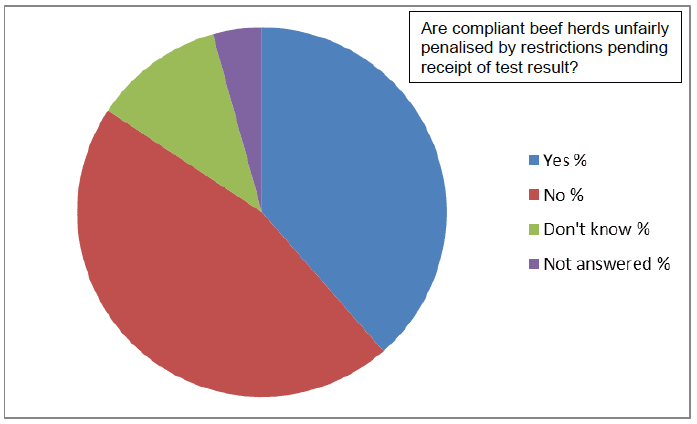Scottish Bovine Viral Diarrhoea eradication scheme: consultation on phase five responses
Analysis of responses to the Scottish Government's public consultation on phase five of the Bovine Viral Diarrhoea (BVD) eradication scheme.
Proposal 7 - Post-sample movement restrictions
Cattle keepers can find themselves in the position of having inadvertently moved their animals illegally when they have not realised that the herd status has changed from BVD "negative" to "not negative" following a check test.
Ideally cattle keepers should look up their herd status on the ScotEID BVD database before they move cattle without individual status to another holding or the market. Access to the ScotEID database is free of charge and users can look up herd status without logging-on to the system.
To prevent the dispersal of animals immediately after a change of herd status, we sought views on restricting herds where a cattle keeper has submitted samples and is waiting for the results of the check test. This would mean that the movement of any animals off the holding that do not have an individual BVD status would have to be delayed until the negative result is uploaded to ScotEID.
Question 19: Do you agree with the proposal to restrict the movement of untested animals off a holding until the results of the annual beef check test have been received?
60% of respondents agreed that restrictions should be imposed until check test results were received, 21% disagreed. Of those who agreed, 6% of respondents mentioned the benefits of having animals available for re-tests if needed. 12% said that the restrictions should only be imposed if approved laboratories could guarantee to return results rapidly and 6% said that restrictions should be imposed on a risk-basis, depending on the herd's test history. Of those who disagreed, 9% pointed out that the scheme is based on an annual BVD herd status and movement should be permitted whilst the herd is BVD "negative". 6% drew attention to the difficulties in holding cattle pending results on those farms that rely on weaning, testing and moving calves off in a very short time period (particularly applicable to small herds). Some respondents commented on the danger of damaging the vet-client relationship due to delays in selling stock, also the potential problem of deterring testing until after young cattle have been sold for the season - making check testing less accurate in the long term (see next question). One respondent emphasised the dangers of discouraging check testing "[by] making check tests even more awkward there will be more movement to tagging and transient infections will continue to be missed."; another highlighted the importance of maintaining farmer engagement with the BVD eradication scheme: "It might undermine approval in the fairness and logic of the scheme if farmers who believe they are adhering to the scheme and are doing everything "right" are unable to sell at certain times of year".
Figure 21: Do you agree with the proposal to restrict the movement of untested animals off a holding until the results of the annual beef check test have been received?

Question 20: Could imposition of movement restrictions encourage cattle keepers to delay their annual check test until after young stock sales, with possible loss of eligible age animals?
66% of respondents thought that delaying the annual check test would be a foreseeable risk of introducing restrictions pending results. 16% of respondents thought that movement restrictions would not cause farmers to delay their check testing. Of those respondents who agreed that restrictions might cause farmers to delay their test, one pointed out the risk of poorer quality check test information: "Some valuable information about the herd BVD exposure might be lost because of farmers strategically timing the annual check test to avoid movement restrictions impacting on their business". Another noted the importance of maintaining engagement with the scheme: "It is better to work with farmers than against them".
Figure 22: Could imposition of movement restrictions encourage cattle keepers to delay their annual check test until after young stock sales, with possible loss of eligible age animals?

Question 21: Should more use of ScotEID be encouraged, e.g. through guidance or at road shows rather than via legislation?
80% of respondents thought that ScotEID use should be encouraged, 7% said no. Comments were supportive of more training and support for cattle keepers to increase use of ScotEID.
Figure 23: Should more use of ScotEID be encouraged?

Question 22: Does this proposal unfairly penalise beef breeding herds that have had a negative status for several years?
Respondents were fairly evenly split on this question. 39% of respondents answered no, beef herds would not be penalised; 46% said yes. Of the respondents, 11% thought that farmers should be sufficiently organised to check test at a time that avoids the impact of restrictions, 13% felt that the penalty of restrictions pending results would be worth it for the benefits to the scheme, with one respondent pointing out "Any herd's status can change". 4% observed that the penalty would be minimised by rapid reporting of test results. 4% suggested that restrictions should be imposed on a risk-basis ( e.g. a herd that had been negative for 2 years should not be restricted pending receipt of test results). 9% felt that the proposal would penalise compliant farmers, and one commented on the impact on farmer engagement: "It is important not to penalise BVD negative herds by adding extra restrictions on movements or they will become disillusioned with the scheme".
Figure 24: Does this proposal unfairly penalise beef breeding herds that have had a negative status for several years?

Contact
There is a problem
Thanks for your feedback